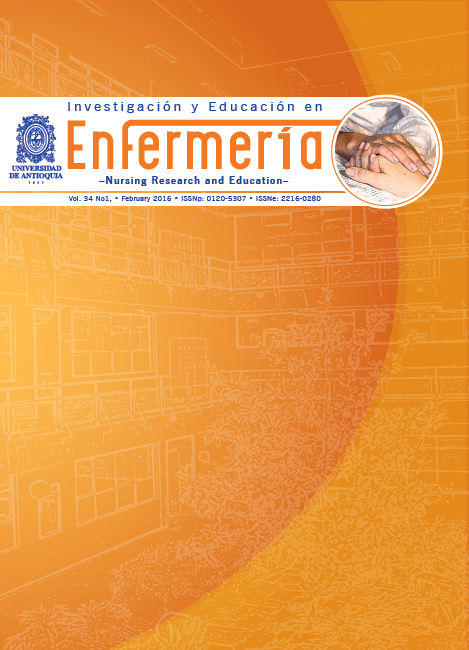Classification tree for the assessment of sedentary lifestyle among hypertensive
DOI:
https://doi.org/10.17533/udea.iee.25995Keywords:
Cross-sectional studies, decision trees, diabetes mellitus, hypertension, nursing diagnosis, sedentary lifestyle.Abstract
Objective. To develop a classification tree of clinical indicators for the correct prediction of the nursing diagnosis “Sedentary lifestyle” (SL) in people with high blood pressure (HTN).
Methods. A cross-sectional study conducted in an outpatient care center specializing in high blood pressure and Mellitus diabetes located in northeastern Brazil. The sample consisted of 285 people between 19 and 59 years old diagnosed with high blood pressure and was applied an interview and physical examination, obtaining socio-demographic information, related factors and signs and symptoms that made the defining characteristics for the diagnosis under study. The tree was generated using the CHAID algorithm (Chi-square Automatic Interaction Detection).
Results. The construction of the decision tree allowed establishing the interactions between clinical indicators that facilitate a probabilistic analysis of multiple situations allowing quantify the probability of an individual presenting a sedentary lifestyle. The tree included the clinical indicator Choose daily routine without exercise as the first node. People with this indicator showed a probability of 0.88 of presenting the SL. The second node was composed of the indicator Does not perform physical activity during leisure, with 0.99 probability of presenting the SL with these two indicators. The predictive capacity of the tree was established at 69.5%.
Conclusion. Decision trees help nurses who care HTN people in decision-making in assessing the characteristics that increase the probability of SL nursing diagnosis, optimizing the time for diagnostic inference.
How to cite this article: Martins LCG, Lopes MVO, Guedes NG, Menezes AP, Farias OO, Santos NA. Classification tree for the assessment of sedentary lifestyle among hypertensive. Invest Educ Enferm. 2016; 34(1): 113-119
Downloads
References
(1) Chaves DBR. Árvores de Decisão para inferência de Desobstrução ineficaz de vias aéreas e Padrão respiratório ineficaz de Crianças com infecção Respiratória Aguda. [Dissertation]. Fortaleza: Universidade Federal do Ceará; 2011.
(2) Hur H, Park S, Kim S, Storey MJ, Kim G. Activity intolerance and impaired physical mobility in elders. Int J Nurs Terminol Classif. 2005; 16(3-4):47-53.
(3) NANDA International (NANDA-I). Diagnósticos de Enfermagem da NANDA: Definições e classificações, 2009–2011. Porto Alegre: Artmed; 2010.
(4) Guedes NG, Lopes MVO, Cavalcante TF, Moreira RP, Araujo TL. Revisão do diagnóstico de enfermagem Estilo de vida sedentário em pessoas com hipertensão arterial: análise conceitual. Rev Esc Enferm USP. 2013; 47(3):742-49.
(5) Carvalho MV, Siqueira LB, Sousa ALL, Jardim PCBV. A Influência da Hipertensão Arterial na Qualidade de Vida. Arq Bras Cardiol. 2013; 100(2):164-74.
(6) Reis MG, Glashan RQ. Adultos hipertensos hospitalizados: percepção de gravidade da doença e de qualidade de vida. Rev Latino-Am Enfermagem. 2000; 9(3):51-7.
(7) Feijão AM, Gadelha FV, Bezerra AA, Oliveira AM, Silva MS, Lima JW. Prevalência de excesso de peso e hipertensão arterial em população urbana de baixa renda. Arq Bras Cardiol. 2005; 84(1):29-33.
(8) Simonetti JP, Batista L, Carvalho LR. Habitos de salud y factores de riesgo en pacientes con hipertensión arterial. Rev Latino-Am Enfermagem. 2002; 10(3):415-22.
(9) Arslantas D, Ayranci U, Unsal A, Tozun M. Prevalence of hypertension among individuals aged 50 years and over and its impact on health related quality of life in a semi-rural area of western Turkey. Chin Med J (Engl). 2008; 121(16): 1524-31.
(10) Pasquali L. Instrumentação psicológica: fundamentos e práticas. Porto Alegre: Artmed; 2010.
(11) Lopes MVO, Viviane MS, Thelma LA. Methods for Establishing the Accuracy of Clinical Indicators in Predicting Nursing Diagnoses. Int J Nurs Knowl. 2012; 23:134-39.
(12) Kastenbaum B. Epidemiology and Bioestatistics: An Introduction to Clinical Research. Seatle: Springer; 2009.
(13) Santos JC. Fatores de risco e complicações em hipertensos/diabéticos de uma regional sanitária do Nordeste brasileiro. Rev Esc Enferm USP. 2012; 46(5):1125-32.
(14) Silva NT, Giacon TR, Costa MP, Vitor ALR, Vanderlei LCM. Moreira TMM. Prevalência de correlação entre obesidade, hipertensão arterial e a prática de atividade física. Colloquium Vitae. 2011; 3(1):32-6.
(15) Nascente FMN, Jardim PCBV, Peixoto RMG, Monego ET, Moreira HG, Vitorino PVO, et al. Hipertensão arterial e sua correlação com alguns fatores de risco em uma cidade brasileira de pequeno porte. Arq Bras Cardiol. 2010; 95(4):502-9.
(16) Gus I, Fischmann A, Medina C. Prevalência dos fatores de risco da doença arterial coronariana no Estado do Rio Grande do Sul. Arq Bras Cardiol. 2002; 78(5):478-83.
(17) Guedes NG. Acurácia das características do diagnóstico de enfermagem Estilo de vida sedentário em portadores de hipertensão arterial. [Dissertation] Fortaleza: Universidade Federal do Ceará; 2008.
Downloads
Published
How to Cite
Issue
Section
License
Derechos de propiedad / Direitos de Propriedade
English: If the article is accepted for publication, all copyright will be of exclusive property of Investigación y Educación en Enfermería. The text and the graphics included in the publication are exclusive responsibility of the authors and not necessarily reflect the thought of the Editorial Committee.
Español: Si el artículo es aprobado para publicación, todos los derechos son de propiedad de Investigación y Educación en Enfermería. El texto y las gráficas incluidas en la publicación son de exclusiva responsabilidad de los autores y no necesariamente refleja el pensamiento del Comité Editorial.
Português: Se o artigo for aceito para publicação, todos os direitos autorais serão de propriedade exclusiva de Investigación y Educación en Enfermería. O texto e os gráficos incluídos na publicação são de responsabilidade exclusiva dos autores e não refletem necessariamente o pensamento do Comitê Editorial.















